Insects attack all parts of the maize plant and attack the plant through all stages of plant growth. Numerous insect species attack maize in North America but the economic importance of the various species differs by region. The insects discussed are grouped according to the plant parts that they feed on: 1) Seed, Root and Lower Stem Feeders 2) Leaf Feeders and 3) Ear Feeders. This section examines those that attack the ear. Specific insects discussed in this section are: corn earworm, western bean cutworm fall armyworm, variegated cutworm, and sap beetle.
Corn Earworm
Description
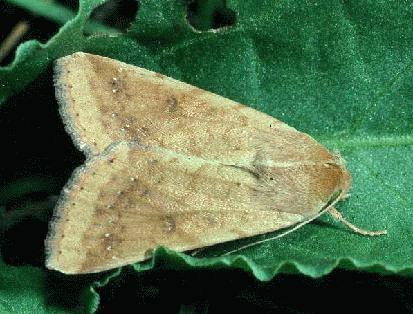
The moths of the corn earworm, Helicoverpa zea (Boddie), are green-eyed, 20 mm long, with a 40 mm wingspan, usually buff-colored, sometimes with shades of pink or green, and with dark forewing markings (figure). Hindwings are light, but have dark margins. Adults range in size from about 12 to 19 mm in length. Eggs, about half the size of a pinhead, are an off-white to yellowish color, and dome-shaped with ribs converging on the top. The larvae range in color from light green (light phase) (figure below, left) to almost black (dark phase) (figure below, right). Earworms may vary greatly in color, but all have three or four black stripes running the full length of the body. Basic body coloration may be green, yellow, black, brown or even pink. The head is light brown with faint mottling or spots. Most distinctive are the numerous microspines on the skin which can be seen with a hand lens. Mature larvae are up to 50 mm long.
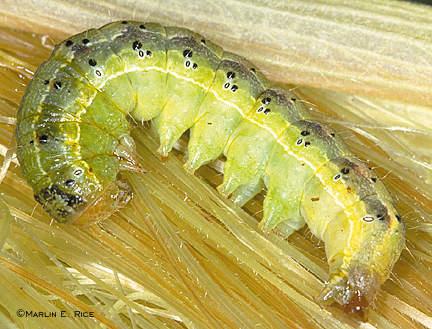
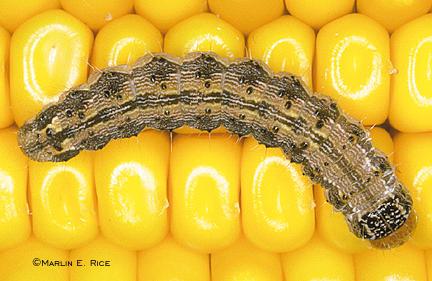
Biology and Life Cycle
The corn earworm is native to North America and is found throughout maize growing regions. The earworm probably does not overwinter in the central states, although larvae have been collected as early as April in Nebraska. Instead, the insect reestablishes itself each spring when southern moths fly northward.
Eggs are placed singly on maize leaves. A red ring appears around the egg after 24 hours and the black larval head capsule is visible in three to four days. Eggs hatch in 10 days or less. There are five or six larval stages. When feeding is completed, the larvae drop to the ground and enter the soil where they transform into shiny brown pupae. In a few weeks the moths emerge to mate and deposit eggs for the second generation. These locally emerging moths, plus additional migrants from the south, are the parents of the larvae found in maize ears in mid-to-late August. Eggs are laid three or four at a time on the green silks. After eggs hatch, young larvae proceed down the silk channels into the ear tips. Corn earworms are cannibalistic, therefore only one will normally mature in each ear. A larva may move from one ear to another. When ear feeding is completed, the larva leaves the ear through an exit hole made in the husk. The larva then moves down the stalk or drops to the ground where it pupates in a cell about 75 to 125 mm deep in the soil. Moths emerge after a pupation period of about 2 to 3 weeks. In warm climates (south of 40° north latitude), they overwinter as pupae in the soil. There may be 6 generations in the southern states but in the central Corn Belt area there are 1 to 2 generations.
Damage
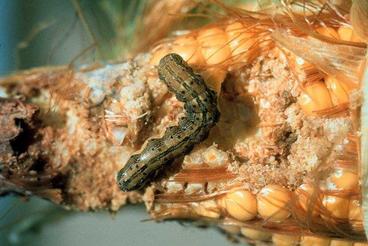
The corn earworm is a common pest of many crops including cotton, tobacco, tomatoes, soybeans, sweet corn, popcorn, and field maize. This pest is distributed throughout North America and is one of the most damaging pests of maize. Early in the season, larvae feed in the terminal of young maize plants damaging the leaves and develop on tassels. These larvae may tunnel into the ears. When fresh silk is available the eggs are laid on the silk, and the larvae first feed on the leaves or bore directly into the silk. Maize ears attacked by the corn earworm have masses of moist castings at the end, and the kernels at the tip of the ear are eaten down to the cob by the larvae (figure, left).
Western Bean Cutworm
Description
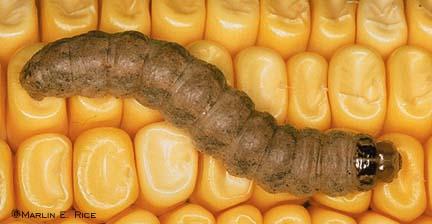
The western bean cutworm, Loxagrotis albicosta (Smith) adult is a typical cutworm moth about 25 mm long, which flies at night and is attracted to light. The forewings are brown with distinct round and kidney-shaped markings, with a light tan stripe at the leading edge. The hind wings are light grey or white. Eggs are cream-colored and deposited in masses. Small western bean cutworms are similar to young armyworms. These two species are difficult to separate without microscopic examination until they are about one-third grown. At the third instar (roughly 13 mm long), western bean cutworm larvae are not obviously striped, unlike armyworms, and body color varies from cream to tan. A light area runs lengthwise down the middle of the back. This light area is bordered on each side by an irregular, scalloped, broken dark area that extends to spiracles or breathing holes. On the prothoracic shield, just behind the head, are three white stripes running from front to back.
Biology and Life Cycle
The western bean cutworm is injurious to maize in several western states and has extended its range eastward into Nebraska and other central states (figure). It overwinters as a prepupa in an earthen cell in the soil. In May and June it transforms into a shiny, reddish brown pupa. In July, the moth emerges from the pupa and pushes its way to the soil surface. Once mated, the females deposit masses of cream-colored eggs in maize whorls. As leaves expand and unfurl out of the whorl, eggs will appear on the upper surfaces. Eggs darken to a purplish color as they develop and hatch in about 7 days, after which young larvae disperse over the maize plants. Larvae feed on maize for about three to four weeks during which they reach a length of about 40 mm. They then drop to the ground. The larvae then burrow into the soil and form an earthen cell, and enter the prepupal stage which overwinters.
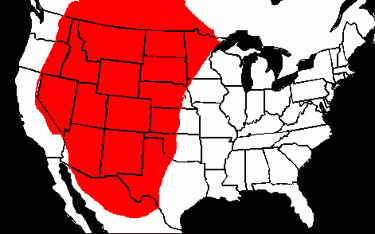
Damage
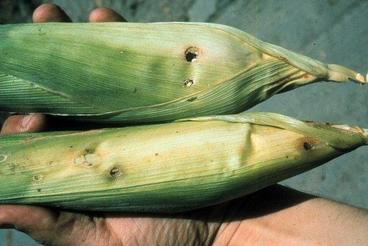
The western bean cutworm is primarily a pest of field beans but is occasionally injurious to maize in several western states. Damaging infestations have been recorded in the Platte River Valley in central Nebraska. Depending on plant growth stage, the larvae may proceed to the unfolding whorl where they feed on parts of the emerging tassel, or move directly to the ear or leaf axil. Once on the ear, they may bore in through the husk (figure, left) or proceed to the tip, where they feed on green silk and later penetrate the ear through the silk channel and feed on the developing grains (figure below, left). Late feeding on dented kernels results in scraping or removal of whole or partial kernels (figure below, right).
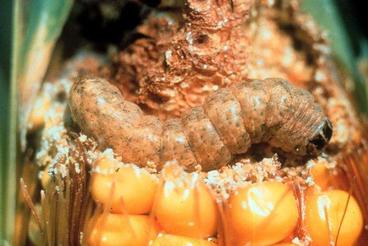
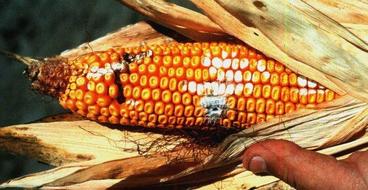
Fall Armyworm
Description
The fall armyworm, Spodoptera frugiperda (J. E. Smith) adult has a wingspan of about 39 mm. The hind wings are grayish-white; the front wings are dark gray, mottled with lighter and darker splotches. Each forewing has a noticeable whitish spot near the extreme tip. Minute, light gray eggs are laid in clusters and covered with grayish, fuzzy scales from the body of the female moth. The eggs become very dark just before hatching. The general appearance of the fall armyworm larva is similar to that of the armyworm. The fall armyworm varies in color from light tan to green to black. Three yellowish lines run down the back from head to tail. These are bordered on either side by a dark stripe and a wide yellow stripe with faint reddish markings or blotches. On the head is a white, upside down Y-shaped marking that clearly distinguishes it from the armyworm. Larvae have four pairs of fleshy abdominal prolegs in addition to the pair at the end of the body. On the tail are eight obvious tubercles, or dark colored bumps, each with a strong seta or hair arising from it. Full grown larvae are about 30 to 40 mm long. The pupa, approximately 13 mm long, is at first reddish-brown but darkens to black as it matures.
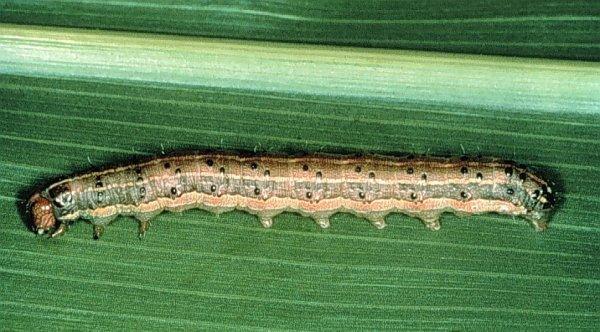
Biology
The fall armyworm is found throughout most of the U.S. It is continuously present in the Gulf States, and the tropics of Central and South America. The fall armyworm is unable to overwinter at northern latitudes and migrates northward each spring. Annually it migrates as far northward as Montana, Michigan and New Hampshire. In Nebraska, little activity is seen until late July or early August when a few moths begin to show up in blacklight traps.
The life cycle of the fall armyworm is similar to those of the corn earworm and armyworm. Eggs are laid in masses of about 100, usually on the leaves of host plants, such as grasses around field margins. The spherical gray eggs are covered with a coating of moth scales or fine bristles. Larvae hatch in 3 to 5 days, feed on the remains of the egg mass, and move to the whorl. When abundant, the larvae may eat all the available food and then move in armies to adjoining fields. After feeding for 2 or 3 weeks, the larvae burrow about 20 mm into the ground to pupate. Within 2 weeks, a new swarm of moths emerges, usually flying several miles before laying eggs. There may be 3 to 4 generations per year in the southern portion of its range. They overwinter mostly as pupae in the soil.
Damage

Maize, sorghum, and other plants of the grass family are the preferred foods, but the fall armyworm also attacks alfalfa, bean, peanut, potato, sweet potato, turnip, spinach, tomato, cabbage, cucumber, cotton, tobacco, all grain crops, and clover. The fall armyworm is one of the more difficult insect pests to control in maize. While fall armyworms can damage maize plants in nearly all stages of development, late planted fields and later maturing hybrids that have not yet silked are more likely to become infested. Unlike the armyworm, the fall armyworm feeds during the day and night, but is usually most active in the morning or late afternoon. It causes serious leaf feeding damage, feeds on undeveloped tassels of young plants, causes direct injury to the ear, and the larvae may bore in stalks. The most common damage is to late pretassel maize. Very early symptoms of fall armyworm resemble European corn borer infestation. Small holes and "window pane" feeding in the leaves emerging from the whorl are common. Late instar fall armyworm larvae consume large amounts of leaf tissue resulting in a ragged appearance to the leaves similar to grasshopper damage (left figure). Larger larvae are usually found deep in the whorl often below a "plug" of yellowish brown frass. Plants often recover from whorl damage without any reduction in yield. Larvae will also move to the ear as plants begin to tassel and young ears become available (figure, below). The ear may be partly or totally destroyed. Damage to the ear may be much more important than leaf damage. In Nebraska, the fall armyworm is a more important pest of sweet corn than of field maize.
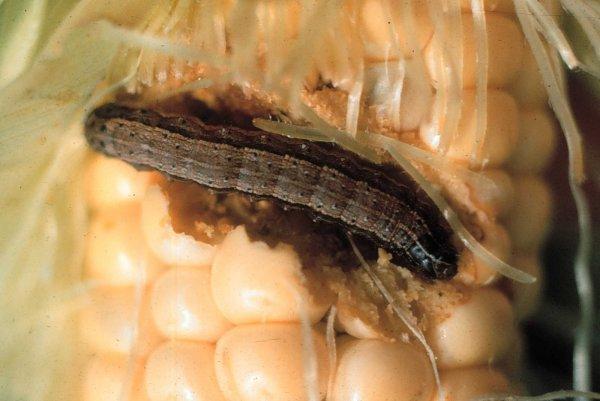
Variegated Cutworm
Description

The forewings of the variegated cutworm, Peridroma saucia (Hübner) adult are yellow or brown with pale mottled designs, with a dark brown spot at the upper edge of each forewing. The hind wings are white with brown veins and margins. The wingspan varies from 3.8 to 5.0 cm. The spherical white or pale yellow eggs are ribbed and slightly less than 1 mm in diameter. They are laid in irregular elongate patches and turn brown before hatching. The variegated cutworm larva (figure) is grey to blackish, with an orange stripe on each side of its cylindrical body. A "W"-shaped black marking is present on the tip of the abdomen, especially in larger specimens. Behind the head is a row of small yellow dots extending along the midline of the back. The mature larva may be as long as 40 mm and curls into a C-shaped ball when disturbed. The pupa is reddish-brown and is 15 to 20 mm long.
Biology and life History
The range of the variegated cutworm spans most of North America including Canada and Alaska and extends into South America. It is also found in Europe and the Mediterranean area. It is of most importance in the Pacific Northwest and some northeastern states. It is an occasional pest of alfalfa, soybeans and home vegetable and flower gardens.
Variegated cutworms overwinter as pupae with a high percent mortality occurring during this life stage. The first moths begin to emerge early in May in Nebraska. Female moths lay over 2,000 eggs during their short life span. Groups of 75 or more eggs are deposited on stems or leaves of low-growing plants. The small white eggs turn dark purplish-grey when nearly ready to hatch, which is about 5 days in the summer. Larvae feed at night and on cloudy days for about 25 days before burrowing into soil to pupate. The pupal stage lasts two weeks to a month before second generation moths emerge. About 7 weeks are required to complete a life cycle and variegated cutworms produce two to four generations each year. In Nebraska, there are at least two generations each year, with the second of most concern to maize growers.
Damage
The variegated cutworm feeds on a variety of garden crops, trees, vines, grasses, field crops, ornamentals, and greenhouse plants. Damaging infestations, however, are sporadic. The variegated cutworm is one of the few cutworm species that climbs plants to feed, and thus its presence is more noticeable than that of subterranean cutworms. They feed at night and hide in the soil by day. Late larval instars cut off plants at or near the soil surface. Occasionally, when corn is silking, cutworms can be found feeding on the silks at the tip of the ear.
Sap Beetles
Description
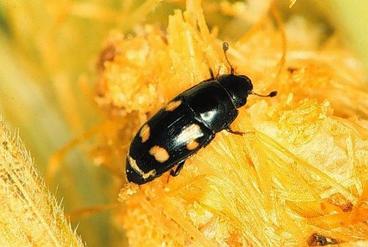
The two common sap beetle species observed in maize ears in the Midwest are the picnic beetle, Glischrochilus quadrisignatus (Say) and the dusky sap beetle, Carpophilus lugubris Murray. The wing covers of sap beetles (especially the dusky sap beetle) are relatively short and do not extend to the tip of the abdomen. Antennae have knobs at the tip (club-shaped) (figure, left). Eggs are laid singly and are milky-white and slender (sausage-shaped), resembling a house fly egg. The picnic beetle is a small, shiny, black beetle about 6 mm long with four irregular yellow or reddish spots on the back. Larvae are white to cream colored with brown heads. The dusky sap beetles are brown, drab looking beetles having no distinguishing marks, with short wing covers, and are about 3 mm long.
Biology and Life Cycle
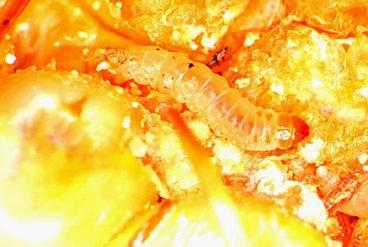
The sap beetles may overwinter as larvae or as adults in decaying vegetation or fruit buried in the soil. In the spring, they emerge and lay their eggs on rotting vegetation. The sap beetles later lay eggs on the silks of maize ears. Females lay 5 to 15 eggs per day. Larvae feed until fully grown, then drop to the soil to pupate. The life cycle is about 30 days with apparently 2 or more generations per year, depending on location.
Damage
Sap beetle adults are scavengers (secondary pests) and breed in fermenting sap emanating from injuries produced by primary ear invaders, such as the corn earworm, European corn borer or western bean cutworm. Both adults and larvae are found on ears. Because sap beetles lay eggs in silks, the larvae that hatch and feed in the ear are suspected of being primary pests. Sap beetles may play a role in furthering the spread of rot organisms (molds) which also damage maize ears. On the positive side, there is some evidence that sap beetles may drive European corn borers from their tunnels in stalks. In any case, damage by sap beetles to ears of maize is slight.